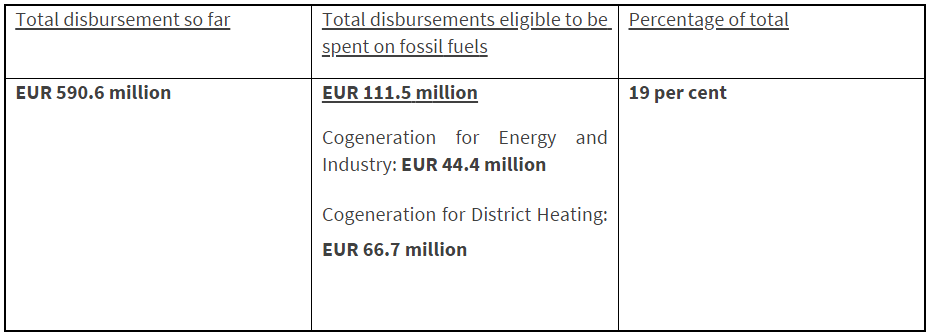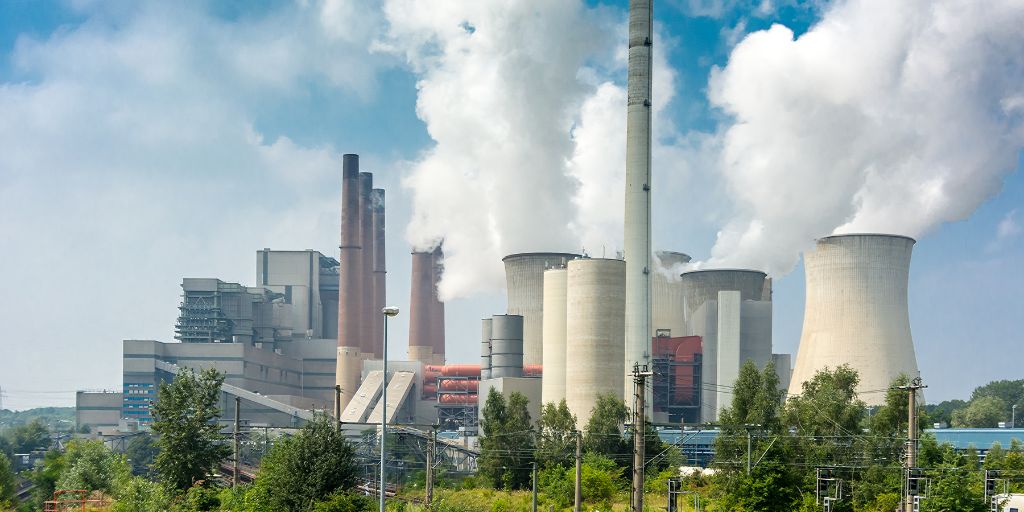Background
The European Parliament agreed on 21 June 2022 to adopt the European Commission’s proposal to exclude fossil fuels financing via the Modernisation Fund. Following the European Parliament’s decision, the Environmental Council will meet on 28 June 2022 to discuss the Emissions Trading System (ETS) revision file, including the future use of the Modernisation Fund.
This document lays out the current state of play regarding the funding of fossil fuels under the Modernisation Fund in four recipient countries in central and eastern Europe: Poland, Romania, Czechia and Slovakia. The document shows that large percentages of the funding allocated for the transition to climate neutrality is being used to fund fossil gas projects. This risks locking in the use of fossil fuels in Member States for decades to come.
Poland
So far, Poland has received funding in three disbursement cycles for eleven investment schemes worth approximately EUR 2.9 billion. Poland has already requested EUR 590.6 million of this amount.
Although most of the investment schemes listed above are indeed in line with Modernisation Fund priorities, a key problem is the limited catalogue of potential beneficiaries. Large, mostly state-owned, energy companies are receiving a disproportionate amount of funding.
There are three particularly controversial schemes supported under the Modernisation Fund in Poland:
- Cogeneration for energy and industry
- Cogeneration for district heating
- The use of alternative fuels for energy purposes
The two cogeneration investment schemes, worth EUR 440 million (already requested for disbursement: EUR 44.4 million) and EUR 666.7 million (already requested for disbursement: EUR 66.6 million) respectively, allow for the use of fossil gas. This means that nearly 19 per cent of funds disbursed to Poland under the Modernisation Fund are earmarked for investment schemes allowing for the use of fossil gas. Another controversial investment scheme, with budget amounting to EUR 666.7 million (of which EUR 266.4 million has been already requested) is aimed at increasing the use of alternative fuels and opens the door to developing and expanding waste incineration installations. The three schemes mentioned were confirmed by the European Investment Bank (EIB) as priority investments, contributing to the Fund’s goals, even though they allow for the use of fossil fuels and waste incineration (the latter of which is not in line with the ‘do no significant harm’ principle).
The Modernisation Fund is managed behind closed doors in Poland, and civil society is not included in the planning and preparation of investment schemes. Public consultations are organised only after the schemes are accepted by the EIB. The indicative list of investments for 2022 and 2023 has not been published. In addition, the Ministry of Climate and Environment considers the Fund an ad hoc instrument to quickly direct money to areas in need, confirming suspicions that there is no unified strategy for spending Modernisation Fund resources by 2030. Thus, it is not possible to determine whether new investment schemes allowing funding for fossil gas will be submitted. Much will depend on the outcome of the ETS Directive Revision and whether gas investments will be excluded from the Modernisation Fund.
 Romania
Romania
EUR 1.4 billion has so far been allocated to Romania from the Modernisation Fund. The funds will aim at financing nine priority sectors.
The European Commission approved the Oltenia Energy Complex’s decarbonisation plan and restructuring plan this year in order to replace existing lignite capacities with fossil gas and reduce greenhouse gas emissions. The Ministry of Energy subsequently announced the submission of two projects to be financed under the Modernisation Fund: the construction of two fossil gas power plants with a total capacity of 1325 megawatts (MW), worth an approximate total of EUR 841 million, with a disbursement from the Modernisation Fund amounting to over EUR 420 million.
No calls for projects were held, and the bureaucratic structure around the Modernisation Fund in Romania has so far been opaque and unclear. This has made it challenging for private companies to apply for funding. Consequently, the only beneficiaries so far are fully or partially state-owned companies. Seventeen priority projects have been approved in 2022 by the EIB and two non-priority projects by the Investment Committee.
Slovakia
Slovakia had a total of EUR 169.5 million disbursed in the second and third disbursement cycles (October 2021 and March 2022) to support:
- Modernisation of energy systems, including energy storage and energy efficiency improvements – rehabilitation and extension of district heating and cooling networks
- High-efficiency cogeneration
- Solar and wind power deployment
All investments thus far have been in the priority sector.
The process has not been sufficient for achieving a sustainable energy transformation. The lack of transparent governance makes it almost impossible to distinguish which projects align with the REPowerEU objectives. Moreover, district heating and cooling networks and high-efficiency cogeneration plants might include fossil gas support. Their overall allocation is EUR 149.5 million – approximately 88 per cent of the first three disbursement cycles.
In addition, Slovakia lacks a vision for ambitious modernisation in the district heating and cooling sector without fossil gas and extensive use of biomass. The Slovak National Energy and Climate Plan is based on outdated policy and provides no pathway to carbon neutrality.
Czechia
Czechia has received EUR 320 million so far for the first two disbursement cycles: EUR 202 million for the first disbursement cycle and EUR 118 million for the second disbursement cycle. For the third disbursement cycle, Czechia is expected to receive an additional EUR 520 million. The following schemes have been supported:
- Support for photovoltaic power plants with installed capacity up to 1 MW from the Renewable Energy Sources+ Programme
- Support for photovoltaic power plants with installed capacity above 1 MW from the Renewable Energy Sources+ Programme
- Modernisation of energy sources priority investments from the programme HEAT
- Modernisation of energy production priority investments from the programme ENERG ETS
We have seen gas projects being funded under the current setup in the Czech Modernisation Plan. One example is the HEAT programme, which supports the use of renewable energy sources and low-carbon sources of energy for heating through changing the fuel base from coal to other sources (mainly gas and biomass) and through modernising heat sources and distribution systems. Nine projects received funding from this programme in 2021: two in the priority sector, and seven in the non-priority sector. According to information provided on the State Environmental Funds webpage, out of these seven projects, five are expected to use gas technology in transitioning from coal. All of the non-priority investments are related to combined heat and power (CHP) technology using gas as a fuel.
In 2022, it is envisaged that another EUR 150 million will finance gas infrastructure. ‘Natural gas’ is directly mentioned in the programmes HEAT and ENERG ETS. Projects that focus on the conversion to ‘natural gas’ with CHP will be from now on considered priority investments. This change in categorisation was approved by the Investment Committee of the EIB. The list of schemes including fossil gas from the third disbursement cycle is as follows:
- Modernisation of energy sources to natural gas without CHP; non-priority investments of the programme HEAT (Modernisation of thermal energy supply system)
- Modernisation of energy sources to natural gas without CHP; non-priority investments of the programme ENERG ETS (Improvement of energy efficiency and reductions of emissions of greenhouse gases in EU ETS industry)
- Modernisation of natural gas energy sources without CHP; ENERG ETS programme
- Modernisation of energy sources to natural gas with CHP; priority investment of the programme HEAT (Modernisation of thermal energy supply systems)
- Modernisation of energy sources to natural gas with CHP; priority investments of the programme ENERG ETS (Improvement of energy efficiency and reductions of emissions of greenhouse gases in EU ETS industry)
- Modernisation of energy sources to natural gas with CHP; priority investments of the programme ENERG ETS (Improvement of energy efficiency and reductions of emissions of greenhouse gases in EU ETS industry) (P‐5 Modernisation of natural gas energy sources with CHP)

Never miss an update
We expose the risks of international public finance and bring critical updates from the ground – straight to your inbox.
Institution: EU
Theme: Advocacy letter
Location: Poland | Czechia | Slovakia | Romania
Project: EU funds and biodiversity | Modernisation Fund
Tags: European Union | fossil fuels



